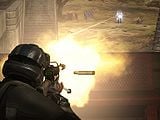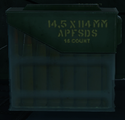14.5×114mm: Difference between revisions
From Halopedia, the Halo wiki
Grim Looters (talk | contribs) mNo edit summary |
Grim Looters (talk | contribs) m (→APFSDS) |
||
| Line 14: | Line 14: | ||
{{Conjecture}} | {{Conjecture}} | ||
Inferring from the designation "armor-piercing, fin-stabilized, discarding sabot", and certain visual depictions, the APFSDS round functions in a similar way to a form of ammunition traditionally used with the cannons of main battle tanks. The bullet is of subcaliber dimensions (meaning that it is too narrow to grip the bore of the barrel), and possesses a long, thin, dart-like shape. Such projectiles can be referred to as a "penetrator" | Inferring from the designation "armor-piercing, fin-stabilized, discarding sabot", and certain visual depictions, the APFSDS round functions in a similar way to a form of ammunition traditionally used with the cannons of main battle tanks. The bullet is of subcaliber dimensions (meaning that it is too narrow to grip the bore of the barrel), and possesses a long, thin, dart-like shape. Such projectiles can be referred to as a "penetrator" or a "flechette". To allow the projectile to function, it is contained while travelling down the barrel in a structural device called a "sabot", which keeps it centered in the bore and is then discarded in flight. The projectile is stabilized in the air by a set of fins, increasing accuracy. Such ammunition has the benefit of minimizing air resistance, allowing it to maintain exceptionally high velocities over long distances which greatly increase effective range, accuracy and penetrative power. They are constructed from dense, hard materials to maximize inertia and resilience, further improving damaging potential.<ref name="WikipediaSabot">'''Wikipedia''', [https://en.wikipedia.org/wiki/Armour-piercing_fin-stabilized_discarding_sabot Armour-piercing fin-stabilized discarding sabot]</ref> | ||
{{Conjecture end}} | {{Conjecture end}} | ||
Revision as of 05:45, May 29, 2020
| There is more information available on this subject at 14.5×114mm on the English Wikipedia. |
- "High velocity, armor-piercing. They'll take the hat off an Elite at two thousand yards. And they ain't cheap."
- — Jun-A266
The 14.5×114mm round is used by the United Nations Space Command's SRS99 series of sniper rifles. Multiple ammunition types are available in this cartridge.
Overview
This ammunition shares its stated dimensions with a powerful cartridge developed in the 20th century by the Soviet Union, intended as an anti-materiel and machine gun round.[1] The UNSC employ it in their own anti-materiel sniper rifles, which are highly effective when used to engage and destroy enemy equipment, vehicles and infantry, though the latter is not their intended primary function. It has been noted, however, that in an anti-personnel role, weapons firing this cartridge possess admirable performance against advanced Covenant energy shield technology.[2] While there exists a variety of ammunition types available in this cartridge, they tend to be highly damaging, precise and effective at long range.[3][4][5]
Variants
APFSDS
The 14.5×114mm APFSDS (armor-piercing, fin-stabilized, discarding sabot) round is the most commonly employed ammunition type for use with the SRS99 series.[6] The damaging capability of the 14.5×114mm round is impressive: according to a UNSC serviceman, at 600 yards the round will go through about 13 feet of flesh and bone when fired from an SRS99D-S2 AM sniper rifle.[7] The round is also highly potent at inflicting damage against light vehicles.[6] Ammunition of this type which was utilized in 2557 aboard the UNSC Infinity with the SRS99-S5 AM sniper rifle bore the alphanumeric designation "M232".[8]
Inferring from the designation "armor-piercing, fin-stabilized, discarding sabot", and certain visual depictions, the APFSDS round functions in a similar way to a form of ammunition traditionally used with the cannons of main battle tanks. The bullet is of subcaliber dimensions (meaning that it is too narrow to grip the bore of the barrel), and possesses a long, thin, dart-like shape. Such projectiles can be referred to as a "penetrator" or a "flechette". To allow the projectile to function, it is contained while travelling down the barrel in a structural device called a "sabot", which keeps it centered in the bore and is then discarded in flight. The projectile is stabilized in the air by a set of fins, increasing accuracy. Such ammunition has the benefit of minimizing air resistance, allowing it to maintain exceptionally high velocities over long distances which greatly increase effective range, accuracy and penetrative power. They are constructed from dense, hard materials to maximize inertia and resilience, further improving damaging potential.[9]
HVAP
The 14.5×114mm HVAP (High Velocity, Armor-Piercing) round is substantially different from the APFSDS round: While APFSDS rounds are sub-calibre, dart-like projectiles with a breakaway sabot surrounding an arrow-like bullet, HVAP rounds are full-bore rounds consisting of a core of high-density, hard material surrounded by a full-bore shell of a lighter material such as an aluminium alloy.
HVAP rounds lose velocity and accuracy at long ranges, giving rifles firing this round an effective range of roughly 1800 metres, considerably less than the 2300 metre ranges of the later-developed, APFSDS-firing SRS99C-S2 and SRS99D-S2 rifles.
HEAP
The 14.5×114mm HEAP (High-Explosive, Armor Piercing) round is used by Linda-058 in her personal modified rifle Nornfang.[10] These rounds explode violently on impact, dealing a great deal of damage to the target.[5]
Trivia
- The Steyr ACR is a real-world prototype weapon that was designed to fire a 5.56mm flechette, similar to the 14.5mm APFSDS used in Halo. However, this weapon is a select fire assault rifle, rather than a sniper rifle.
- The 14.5×114mm is actually a Russian heavy machine gun round that was developed for use in anti-tank rifles like the PTRD and PTRS in World War II, later used in Anti-Aircraft and Vehicle-Mounted roles with the KPV; it remains in use to this day.
Gallery
A spent 14.5×114mm brass casing is ejected from the SRS99D-S2 AM sniper rifle.
Jun-A266 giving Noble Six a magazine of 14.5×114mm rounds.
List of appearances
Sources
- ^ Wikipedia, 14.5x114mm
- ^ Halo: The Essential Visual Guide, page 179
- ^ Halo: Combat Evolved, Gameplay
- ^ Halo: Reach, Campaign level "Nightfall"
- ^ a b Halo 5: Guardians, Warzone gameplay
- ^ a b Halo: Official Spartan Field Manual, page 192
- ^ Believe, Enemy Weapon
- ^ Halo 4 Limited Edition, UNSC Infinity Briefing Packet
- ^ Wikipedia, Armour-piercing fin-stabilized discarding sabot
- ^ Halo Waypoint - Cannon Fodder: Locke & Load
| |||||||||||||||||




